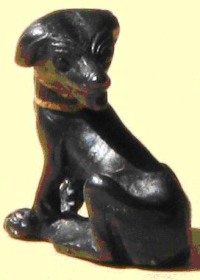New York Metropolitan Museum of Art recognizes Egypt’s title to 19 objects originating from the tomb of Tutankhamun

- Figure of dog, black bronze with gold collar H. 1.6 cm (0.6 in.) Former Museum Accession Number 47.58.1.
- © The Metropolitan Museum of Art
On 10 November 2010, in a statement by the Director of the Metropolitan Museum of Art in New York and the Secretary General of the Supreme Council of Antiquities of Egypt, the Metropolitan Museum of New York formally acknowledged that 19 objects originating from the tomb of King Tutankhamun belong to Egypt.
The objects have been part of the Met’s collection since the early 20th century. After in-depth research by its Department of Egyptian Art, the objects can now be identified with certainty as originating from the tomb of King Tutankhamun. Already at the time of the excavations, exportation of the objects was prohibited by law, which makes Egypt the rightful owner of the objects. The Metropolitan Museum of Art is one of the main partners in Egypt’s quest to recover its illegally exported cultural property. It provides Egypt with expertise, leading for example in 2009 to the return of an ancient granite relief inscribed with the name of Amenemhat I who ruled Egypt from 1991 to 1962 BC. The 19 objects will return to Egypt in June 2011. After being exhibited at the Egyptian Museum in Cairo, they will be transferred to the Grand Egyptian Museum in Giza with the rest of the Tutankhamun collection. For 40 years now, UNESCO is actively involved in the return and restitution of stolen and illicitly exported cultural property, as expressed by the Director-General in his plea of 1978 "For the Return of an Irreplaceable Cultural Heritage to those who Created It". UNESCO encourages Member States who have lost certain cultural objects of fundamental significance and who are calling for their restitution or return, to apply international principles, in particular those promoted through the 1970 UNESCO Convention and 1995 UNIDROIT Convention. In cases where international conventions cannot be applied, States are encouraged to call on the Intergovernmental Committee for Promoting the Return of Cultural Property to its Countries of Origin or its Restitution in Case of Illicit Appropriation, which seeks ways and means of facilitating bilateral negotiations, in particular through the newly adopted rules on mediation and conciliation, promoting multilateral and bilateral cooperation with a view to the restitution or return of cultural property as well as fostering a public information campaign on the issue, and promoting exchanges of cultural property.
For more information on the Intergovernmental Committee, click here.
- Source:UNESCO
- 10-12-2010


